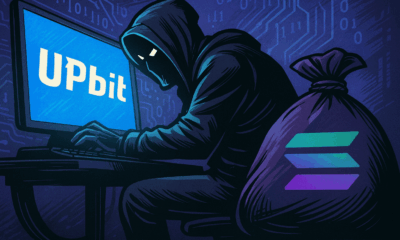Ethereum
Ethereum’s Developer Magnetism: 16,000 New Devs in 9 Months Signals Momentum — But Question Marks Loom

- Share
- Tweet /data/web/virtuals/383272/virtual/www/domains/theunhashed.com/wp-content/plugins/mvp-social-buttons/mvp-social-buttons.php on line 63
https://theunhashed.com/wp-content/uploads/2025/10/ethereum_developers-1000x600.png&description=Ethereum’s Developer Magnetism: 16,000 New Devs in 9 Months Signals Momentum — But Question Marks Loom', 'pinterestShare', 'width=750,height=350'); return false;" title="Pin This Post">
In the high-stakes arena of blockchain platforms, traction often comes down to one metric: how many developers are building. A recent report suggests that Ethereum’s ecosystem has bucked industry inertia, drawing over 16,000 new developers between January and September of this year. But behind the headline lurk nuanced debates — about data integrity, AI‑augmented coding, and what “joining” really means.
A Developer Influx (By the Numbers)
According to the Ethereum Foundation, which cites data from Electric Capital, more than 16,000 newcomers entered the Ethereum ecosystem in the first nine months of the year. That puts Ethereum at the top of the developer heap: the ecosystem now counts on 31,869 active developers when combining Layer‑1 Ethereum and its Layer‑2 extensions such as Arbitrum and Optimism.
By contrast, the report claims Solana added approximately 11,500 developers in the same period, and Bitcoin around 7,500. Ethereum’s growth, however, is more modest when viewed in relative terms: full-time developers within Ethereum only climbed by 5.8% over the past year, and 6.3% over two years. Meanwhile, Solana showed 29.1% year‑over‑year growth and 61.7% over two years, though with important caveats.
It’s also worth noting that Ethereum’s numbers include its Layer‑2 networks but intentionally avoid double‑counting developers who work across multiple chains, which reflects an effort to present a more accurate picture of its ecosystem’s health.
Solana’s Challenge: Underreporting or Outpacing?
The Solana Foundation has pushed back against the numbers, arguing that Electric Capital’s metrics may undercount Solana by as many as 7,800 developers. The discrepancy stems from limitations in data collection tools — some repositories and developer activities simply fall outside of the dataset’s reach.
This debate underscores a larger issue: the difficulty of accurately capturing developer activity in a decentralized and often opaque environment. It’s not enough to simply tally GitHub commits or active repositories. Many developers reuse tools across EVM-compatible chains like Polygon and BNB, which suggests that the entire EVM ecosystem benefits from overlapping talent pools and shared infrastructure.
Coding Bots, Hackathons & “Vibe Coding”
The raw numbers also raise questions about what kind of development activity is being counted. Jarrod Watts, a developer from the Layer‑2 project Abstract, voiced skepticism about the true nature of these contributions. He suggested that a significant portion of new repositories might be generated during hackathons or by AI tools and never maintained or deployed into live systems. Watts even remarked that he couldn’t name a single new crypto developer who started this year, implying that the surge may be more symbolic than substantive.
This raises concerns that many of these new “developers” may only be dabbling, creating experimental codebases that aren’t maintained or used in production. In that context, Ethereum’s 16,000 new developers may not all represent durable, long-term contributors.
Why Ethereum Still Commands Attention
Despite the methodological uncertainties, Ethereum’s ability to attract and retain developers remains impressive. The platform benefits from a combination of technical maturity, wide adoption, and robust developer infrastructure. Its use of the Ethereum Virtual Machine (EVM) creates a standardized environment where skills can easily transfer across projects and even other chains. The broader infrastructure—spanning grants, community support, and documentation—lowers the barrier for entry and sustains engagement.
Additionally, Ethereum’s Layer‑2 scaling solutions, such as rollups, expand the playground for developers. These tools increase throughput while reducing transaction costs, making it easier to launch and test new decentralized applications without the risk of high fees. Together, these factors create an ecosystem that is not only attractive but also sticky.
What to Watch Going Forward
Looking ahead, several trends will determine whether Ethereum can maintain its momentum. First is the issue of retention. It’s not just about attracting developers—it’s about keeping them active, engaged, and productive over the long term. Second, the influence of AI in software development is complicating traditional metrics. As tools like GitHub Copilot automate coding tasks, distinguishing between meaningful contributions and boilerplate code becomes harder.
There’s also the question of cross‑chain movement. Developers may continue to explore ecosystems like Solana or Cosmos, especially if those chains offer better performance or financial incentives. Finally, governance and funding models will play a critical role. Ecosystems that can convert developer activity into meaningful rewards and participation in protocol decisions are likely to see more sustained growth.
Ethereum
Small Kingdom, Big Move — Bhutan Stakes $970 K of ETH via Figment to Back National Blockchain Ambitions

Bhutan Turns Heads With Institutional‑Grade ETH Stake
The government of Bhutan quietly moved 320 ETH — worth roughly $970,000 — to Figment, the well-known staking provider, signaling a major shift in how the Himalayan kingdom engages with crypto. Rather than a speculative or retail‑style buy, this is an institutional‑level stake: the amount deployed corresponds to 10 full Ethereum validators (since each validator requires 32 ETH).
More Than Just Yield: Bhutan Anchors Crypto in Governance
Bhutan’s ETH stake comes on the heels of a far broader crypto‑adoption push. In October 2025 the country launched a sovereign national digital identity system — built not on a private chain, but on the public Ethereum blockchain. The decision to anchor citizen identities on a decentralized, globally supported network like Ethereum underscores a long‑term vision: decentralized identity, on‑chain transparency, and national infrastructure built with blockchain.
For Bhutan, this ETH stake isn’t about short‑term price swings or hype — it reflects a strategic bet on Proof‑of‑Stake infrastructure. By running validators via Figment, the government contributes to network security, potentially earns rewards, and aligns its own holdings and governance systems with the protocols underlying its digital‑ID rollout.
What This Signals for Ethereum — and for Crypto Governance
Though 320 ETH is a drop in the bucket compared to total staked ETH globally, the move carries symbolic weight. A sovereign state publicly committing funds to ETH staking via a recognized institutional provider adds to the broader narrative: that Proof‑of‑Stake networks are maturing, and that blockchain can underpin more than speculative assets — it can support identity, governance, and long-term infrastructure.
Moreover, it highlights that institutional staking services like Figment are increasingly trusted not only by hedge funds or corporations, but by governments. According to Figment’s own data, their Q3 2025 validator participation rate stood at 99.9%, and they reported zero slashing events — underlining the reliability such clients are counting on.
What to Watch Next
Will Bhutan stake more ETH? On‑chain data shows the wallet still holds a portion of ETH that remains unstaked — suggesting potential for future validator additions.
Will other nations follow suit? If Bhutan’s mixed use of crypto — combining reserve assets, public‑service infrastructure, and staking — proves viable, it could serve as a blueprint for other smaller states looking to modernize governance with blockchain.
Will this affect ETH’s valuation? Hard to say immediately. The 320 ETH is unlikely to move market prices by itself. But if this step becomes part of a larger trend toward institutional and sovereign staking, the cumulative effect on demand and network security could indirectly support ETH’s long-term value proposition.
Ethereum
Vitalik Buterin’s $760K Bet on Privacy: What His Donation to Session & SimpleX Chat Signals for Crypto Messaging

The Ethereum Co-Founder’s Move Sends a Clear Message
When Vitalik Buterin committed a six-figure sum to two emerging privacy-focused messaging apps, it wasn’t just philanthropy — it was a strategic statement. Buterin donated 256 ETH, worth around $760,000, split evenly between Session and SimpleX Chat. His stated goal was to support projects pushing the boundaries of messaging privacy, especially those eliminating traditional identifiers like phone numbers and making metadata invisible.
This kind of move doesn’t happen in a vacuum. In a time when digital surveillance is tightening and governments are scrutinizing communication platforms with increasing intensity, Buterin’s gesture highlights a pivot: from just end-to-end encryption to full-stack privacy, where even metadata — who, when, how often — is protected.
Why Session and SimpleX Matter Now
Session and SimpleX represent a different paradigm from mainstream encrypted apps like Signal or Telegram. Session leverages a decentralized onion-routing network to remove central points of failure and obscure the origin and destination of messages. It doesn’t require a phone number or email to create an account, which means your communication identity isn’t linked to your real-world ID.
SimpleX Chat takes a similarly radical approach. It discards all global user identifiers and uses temporary, non-persistent session IDs. By default, it avoids any server-side storage of user metadata. This pushes the envelope on what private messaging can mean in a Web3 context.
But these aren’t just fringe apps. They represent a broader movement aiming to decouple identity from communication — something that increasingly resonates in crypto-native communities, where pseudonymity and sovereignty are core values.
More Than Encryption: The Metadata Battle
Traditional “secure messaging” has largely focused on content encryption — making sure only sender and receiver can read the messages. But in reality, metadata often tells a more powerful story. When messages were sent, how often you interact with someone, and your communication graph can all be used for behavioral profiling or even retroactive surveillance.
Buterin made clear that metadata privacy is what matters most now. Without tackling this, he argued, truly private communication cannot exist. That’s what sets his donation apart from the usual talk around encryption — it’s a direct endorsement of messaging without identifiers, without centralized relays, and without traceable networks.
This push is timely. As lawmakers in the EU and elsewhere explore so-called “chat control” proposals that would force companies to scan messages or retain metadata, the crypto space is responding by building alternatives. These aren’t just apps — they’re defensive tools for digital sovereignty.
A New Standard for Web3 Messaging
The implications for the broader crypto and Web3 landscape are significant. Messaging is the most common digital activity, and yet Web3 has largely ignored it in favor of finance and infrastructure. But with Buterin’s donation, a clear priority emerges: communication deserves the same decentralization and privacy guarantees that DeFi or NFTs claim to offer.
These apps could become part of a broader stack of decentralized identity and communication tools. Imagine wallets that message, DAOs that coordinate privately, or pseudonymous communities built on trustless comms. It’s not hard to see a future where crypto-native messaging protocols replace traditional platforms for everything from coordination to customer support.
That said, the technical challenges are steep. Delivering strong metadata privacy without sacrificing multi-device support, uptime, or usability is no easy feat. Session, for instance, still struggles with message delivery in fringe networks. SimpleX is relatively new and has yet to scale its infrastructure globally.
But if these projects succeed, they may define what Web3 communication should look like: decentralized, permissionless, and invisible to the watchers.
What Comes Next
Vitalik Buterin’s donation is a catalyst, but it also raises expectations. Privacy-focused apps like Session and SimpleX must now prove they can scale beyond early adopters. That means building user-friendly interfaces, integrating with crypto tools, and making privacy seamless — not a technical obstacle.
If these apps succeed, they could become foundational in the same way MetaMask or Uniswap did in their domains. And if others follow Buterin’s lead — both with capital and adoption — we could see a serious pivot in Web3 toward communication infrastructure that doesn’t leak our lives through metadata.
In the age of AI surveillance, mass data collection, and algorithmic profiling, who you message — not just what you say — is a liability. But with projects like Session and SimpleX now backed by Ethereum’s most influential founder, the path to invisible messaging just got a powerful new boost.
Ethereum
Offchain Labs Pushes Back on Vitalik Buterin’s RISC‑V Proposal, Says WASM Is the Smarter Path for Ethereum

In a move that could influence the next generation of blockchain architecture, Offchain Labs — the core developer behind the Arbitrum ecosystem — has publicly challenged Vitalik Buterin’s recently floated idea to adopt the RISC‑V instruction set architecture (ISA) as the foundation for Ethereum’s execution layer. The research team argues that while RISC‑V has become prominent in zero‑knowledge (ZK) proof systems, it may not be the optimal choice for smart‑contract delivery on layer one. Instead, they propose WebAssembly (WASM) as a more future‑proof format.
The Core of the Debate
Offchain Labs’ researchers introduce a useful conceptual separation: the “delivery ISA” (dISA), which defines how contracts are uploaded and stored on‑chain, versus the “proving ISA” (pISA), which is used by ZK‑VMs to verify execution. They argue that Vitalik’s proposal implicitly assumes a single ISA should serve both roles, but this assumption risks locking Ethereum into a format optimized for today’s ZK proving, not long‑term delivery and flexibility.
The team points out that RISC‑V has shown strong performance in ZK proof contexts, but it does not necessarily perform well in diverse node‑hardware environments, where most clients do not run native RISC‑V CPUs. Emulating RISC‑V on commonly used hardware introduces inefficiencies and may undermine decentralization. WASM, by contrast, executes efficiently on general hardware, is type‑safe, and benefits from a robust and well‑supported developer ecosystem.
Implications for Ethereum’s Future
The research suggests that anchoring Ethereum’s delivery ISA to RISC‑V now could effectively freeze the ecosystem into a proving‑ISA strategy that may become outdated as ZK‑VM architectures evolve. They caution that RISC‑V was never designed primarily for ZK proving or smart‑contract delivery but rather for hardware microprocessors — a fact that limits its long‑term suitability in a general‑purpose blockchain context.
By selecting WASM for contract delivery, with the option to compile it into whatever proving ISA emerges as superior, the blockchain ecosystem retains flexibility, avoids hardware lock‑in, and aligns smart‑contract deployment with a mature and widely supported programming standard. Offchain Labs argues WASM could philosophically serve as an “Internet protocol” layer for smart contracts — agnostic to the underlying hardware or proof system.
Why This Matters Right Now
Ethereum is nearing a set of protocol design decisions that will shape not just the next upgrade, but its evolution over the coming decade. As ZK proof technologies evolve and node hardware becomes increasingly heterogeneous, selecting an ISA for Layer 1 becomes a strategic architectural choice, not just a technical one. If Ethereum adopts an ISA optimized solely for today’s proving stack, it may compromise adaptability, decentralization, and inclusivity across hardware platforms.
Offchain Labs’ response reframes the ISA decision as a battle between flexibility and immediate efficiency. Their argument is simple: prioritize future‑proofing over optimization for today’s ZK tech.
What to Monitor
Over the next several months, developers and observers should keep an eye on Ethereum’s core roadmap and community discussions. Will the network choose separate ISAs for delivery and proving? Will it commit to RISC‑V or pivot to WASM? The maturity of tooling, compiler support, and infrastructure around WASM could prove decisive, especially as alternative ZK‑VM designs begin to experiment with non‑RISC architectures.
Ultimately, this may look like a low‑level implementation dispute, but it reveals something deeper: Ethereum’s infrastructure choices today will define its trajectory for the next decade. The RISC‑V vs. WASM debate is not just about smart contracts — it’s about what kind of computational future Ethereum wants to build.
-

 Cardano2 months ago
Cardano2 months agoCardano Breaks Ground in India: Trivolve Tech Launches Blockchain Forensic System on Mainnet
-

 Cardano2 months ago
Cardano2 months agoCardano Reboots: What the Foundation’s New Roadmap Means for the Blockchain Race
-

 Cardano2 days ago
Cardano2 days agoSolana co‑founder publicly backs Cardano — signaling rare cross‑chain respect after 2025 chain‑split recovery
-

 Bitcoin2 months ago
Bitcoin2 months agoQuantum Timebomb: Is Bitcoin’s Foundation About to Crack?
-

 Cardano2 months ago
Cardano2 months agoAfter the Smoke Clears: Cardano, Vouchers, and the Vindication of Charles Hoskinson
-

 Cardano2 months ago
Cardano2 months agoMidnight and Google Cloud Join Forces to Power Privacy‑First Blockchain Infrastructure
-

 Ripple2 months ago
Ripple2 months agoRipple CTO David “JoelKatz” Schwartz to Step Down by Year’s End, but Will Remain on Board
-

 News2 months ago
News2 months agoRipple’s DeFi Awakening: How mXRP Is Redefining the Role of XRP










